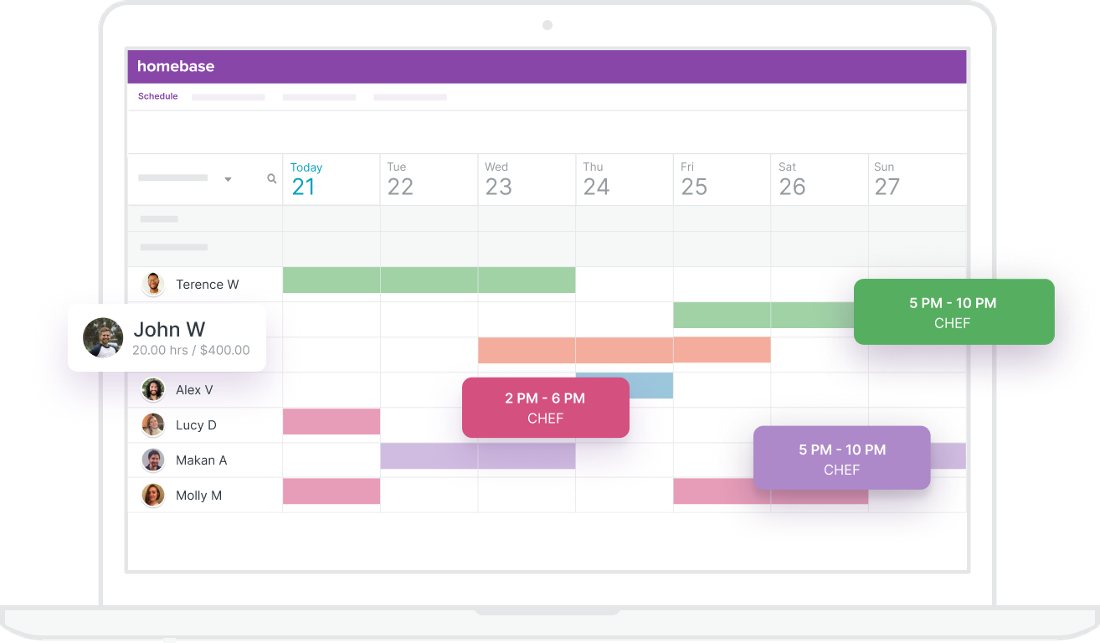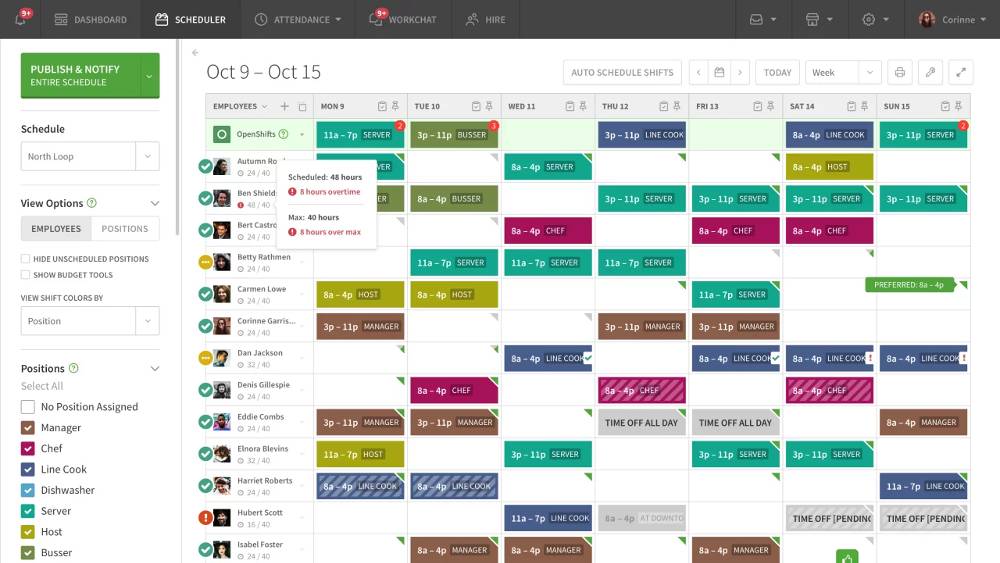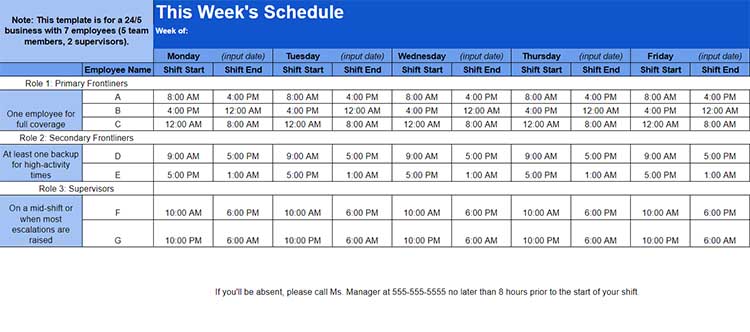An on-call schedule is a type of employee schedule that ensures your business has enough of the right staff to respond to increased customer demand, day or night. Companies in certain industries use on-call scheduling for a variety of reasons, like keeping medical or technology services running and addressing customer concerns.
For the easiest time creating and implementing an on-call schedule, follow the six steps below and download our free weekly on-call schedule template to use as your guide.
Step 1: Pick the On-call Schedule that Works for Your Business
You don’t have to build your on-call schedule from scratch. You can take proven ideas from other organizations and modify them to fit your business needs. If you’re looking for a free scheduling option, visit our article on Free Employee Schedule Templates.
Here are some common types of on-call schedules used today.
On-call scheduling can be a valuable tool for businesses that need to provide 24/7 support to their customers. Common industries that benefit from on-call scheduling include healthcare, security, IT, roadside assistance, building and apartment maintenance, customer service, restaurants, and retail.
Step 2: Determine Employees in Rotation
Next, determine how many employees will be part of the on-call rotation. In some cases, you may be able to get away with having just one on-call staff member in a shift—but certain industries will usually require more employees to keep your business running. As such, you need to make sure your on-call team is big enough to support your needs.
For example, a local plumbing company may need on-call plumbers and dispatchers.
On-call Plumber Rotation
Acme Plumbing, staff includes:
- 22 plumbers (includes six that can handle emergencies and be on call)
- 13 management and support staff (includes eight dispatchers)
- Average emergencies per week = three (requires one on-call plumber)
- On-call rotation consists of six emergency plumbers on call for one week each
Result: Five-week break between on-call shifts allowing for employees to recover.
On-call Dispatcher Rotation
- Acme Plumbing has eight dispatchers that work on-call hours
- Average after-hours requests per week that are emergency or first-morning priority = 20
- After hours are 7 p.m. to 7 a.m.
- Two dispatchers need to be on call
- One from 7 p.m. to 1 a.m., the second from 1 a.m. to 7 a.m.
Result: Dispatchers never work back-to-back shifts and have a three-day break between on-call shifts.
We suggest you vary this rotation, as in the example above. Having one employee work consecutive on-call shifts can quickly lead to burnout.
If you are struggling with employee scheduling or this is your first time to do this, read our guide on how to schedule employees for some expert tips and advice. The guide comes with a free template to help you get started.
Step 3: Identify Shift Hours
Determine what hours the employees are on call. It will easily help you track employee hours and identify which employee is responsible for that particular time slot. Also, note that this should center on your customers’ needs and when they’re most likely to have issues or increased demand. You don’t want a customer to call for help and get a voicemail or enter your store and have no employees free to help them.
Employee Scheduling software like Homebase will allow you to communicate with your team effectively and make everyone aware of the schedule. (Source: YouTube, Homebase, Melanie Lumsden)
For example, as we noted above, the on-call dispatcher hours for Acme Plumbing are 7 p.m. to 7 a.m. This covers unexpected emergencies Acme customers may have outside normal business hours. The 12-hour shift will be shared by two on-call dispatchers, one available between 7 p.m. and 1 a.m. and a second available from 1 a.m. to 7 a.m.
To further assist you, consider using employee scheduling software that automates some parts of the process and reduces the time you need to spend manually building on-call schedules.
Step 4: Examine Employee Skills
On-call shifts can involve skeleton crews or just a single employee. Depending on the needs of your customers, you may want to schedule only certain employees—those with the skills to help your customers quickly.
Unfortunately, that could mean some employees have to spend more time on call than others. By providing better training and development for your employees, you can help them fill the gaps and give your more skilled workers a break.
Step 5: Consider Employee Preference
Building a schedule should include employees’ preferences. Some employees may have medical reasons that they cannot work certain hours. Others may be more productive at different hours of the day. There will also be vacations and sick days to factor in. Taking these items into consideration when building a schedule can greatly increase employee productivity by working with the employee’s schedule.

Homebase will allow you to schedule employees based on their available times as well as list their job functions.
Step 6: Prepare Backups
Effective employee management anticipates busy hours when creating an on-call schedule. Whether you regularly have one employee on call or 10, you should prepare for a scenario that requires backups. These backup employees can be available if the on-call employee scheduled to be the point of contact gets overwhelmed. If your business is in IT, for example, this might occur if your network experiences an outage. You’ll want to have backups available to come and help fix the problems and manage customer expectations.
If you’re tired of using pen and paper, consider using employee scheduling software like When I Work to automate your scheduling and provide you with detailed analytics to improve your on-call workload and prevent employee burnout. Learn more about what it can do for you in our When I Work review.

When I Work will allow you to schedule employees—regular schedules, backup shifts, and PTO.
Having backups is crucial to keeping your business running. We recommend the three-to-one rule—for every three employees working, you have one on-call backup scheduled. Your business needs may vary, so adjust up or down as necessary.
Factors to Consider When Building Your On-call Schedule
Your on-call schedule may need to account for unique customer requests, preferred working hours, company culture, and the number of employees you have available to staff your on-call shifts. However, there are certain things you’ll need to consider regardless of your industry.
Employment Laws
Today, many states and cities are providing for enhanced employee rights, some of which include overtime and on-call requirements for businesses. Some states even require a company to provide advanced notice of the employee’s schedule or face fines. We recommend checking employment laws in your state for good measure.
Work-life Balance
A stable work-life balance is extremely important to most of today’s workforce. Ignoring the desire to be able to disconnect from work and enjoy their personal lives could have negative consequences, ranging from reduced employee engagement to increased turnover.
A recent survey shows that only 50% of the youngest employees in the workforce (those under 25 years of age) are satisfied with their work-life balance. That number increases to 77% for the older workers (those aged 56 and older).
Sticking to a schedule that provides transparency and the ability for employees to plan their personal activities around their work will give you a more engaged workforce. This makes for lower turnover and higher productivity, even if employees encounter frustrating situations during an on-call shift.
On-call Scheduling Best Practices
The steps above outline how to create your on-call schedule, something that software, like Homebase or When I Work, may be able to provide for you. But it doesn’t end there. Maximizing productivity will require consideration of several key factors as you build and maintain your on-call schedule.
Get Your Team’s Insights Regularly
After building your team’s on-call schedule, regular check-ins on how it’s working are extremely important. Your team can deliver key data so that you know when you need to have more people on call, or if you have too many people on call.
Communicating effectively with your team makes them feel valued and gives you the chance to make real-time adjustments to the schedule to meet your customers’ and employees’ needs. Getting too much insight, however, can prevent any action—analysis paralysis. So make sure that you consider the insight and then take action on any necessary changes.
Recognize the Importance of Sleep
One reason on-call teams don’t like on-call schedule uncertainty is that it can disrupt their sleep patterns. Sleep is very important to everyone, especially for doctors who might need to make life and death decisions or factory workers using heavy machinery. You may still need to staff employees overnight, but building a solid rotation of on-call employees can increase their performance.
Practice Supportive Culture
Your company culture may already be a good one that supports team members and provides them with a positive work environment. Even for those companies with a good work culture, on-call schedules can be a source of stress and anxiety, leading to decreased employee engagement.
According to the Gallup State of the Global Workforce report, stress among workers is at an all-time high—44% at the end of 2021.
If an employee needs to deal with a personal emergency, a supportive culture enables other employees to step in and take a shift. Teamwork like this makes every employee feel appreciated and goes a long way to keeping important on-call shifts fully staffed.
Avoid Minor Issues
Customer service and IT support often have a tiered approach. The first level of support provides general guidance to customers, and more serious or complex issues go up the chain. Other businesses can use this same approach.
Not every issue requires immediate action. Determine what your company’s minor issues are so that you can hold those issues until normal business hours or after demand has dropped. This can provide employees more freedom to disconnect, which has added benefits of keeping employees less stressed and more engaged.
On-call Scheduling Mistakes & Solutions
Managing on-call scheduling effectively is crucial for ensuring prompt responses to emergencies and maintaining operational continuity. However, several common mistakes can hinder the success of such schedules. By addressing issues, organizations can create fair and balanced on-call scheduling processes.
- Inadequate planning: Lack of clarity in on-call schedule, insufficient coverage, and unclear responsibilities.
Solution: Develop a well-defined on-call rotation schedule, clearly communicate responsibilities, expectations, and contact information. Utilize scheduling software to automate and manage rotations.
- Unrealistic expectations: Unreasonably high level of availability, lack of work-life balance, and burnout.
Solution: Set reasonable on-call frequency and duration, implement fair rotation policies, and provide additional compensation or time-off incentives.
- Insufficient compensation: Lack of financial and non-financial incentives for on-call duties.
Solution: Review and adjust compensation structures to reflect the additional responsibilities of on-call roles. Consider providing both financial and non-financial incentives.
- No clear escalation path: Lack of clarity in the escalation journey, delayed response times, and critical issues escalating further in severity.
Solution: Craft a well-documented escalation path that describes precise steps to be followed when an incident surpasses the capabilities of the current on-call personnel. This includes outlining specific triggers that warrant escalation, such as the complexity or severity of the issue, and establishing a hierarchy of contacts to reach out to.
- Inadequate Training: Employees feel ill-equipped to navigate high-pressure situations and make decisions.
Solution: Provide robust training sessions that simulate realistic scenarios and allow employees to practice critical decision-making and hone problem-solving abilities. Regularly update training to keep employees current with evolving technologies and best practices.
- Inflexible Policies: One-size-fits-all approach that disregards the complexity and diversity of incidents
Solution: Create flexible on-call policies that can accommodate unexpected changes, such as shift swaps or coverage adjustments. Encourage open dialogue with employees for policy refinement.
- Ignoring feedback: Lack of platform for on-call employees to voice concerns and suggestions
Solution: Regularly solicit feedback from on-call employees through surveys or discussions. Act on their suggestions to enhance the on-call experience.
Pros & Cons of On-Call Schedules
Pros | Cons | |
|---|---|---|
For your business |
|
|
For your employees |
|
|
An ineffective on-call schedule costs your business money and makes for unhappy employees. Combined, these two negatives can reduce your revenue and increase your employee turnover, all while making clients and customers frustrated.
You can avoid this perfect storm by taking control of your on-call scheduling with effective on-call management. A good on-call rotation schedule makes sure that you have coverage for issues and increased customer demand as you need them while maintaining fair rotation between employees and protecting their time and health.
Bottom Line
Understanding what your customers and employees need gives you better insight into how to create your on-call schedule. Building and maintaining an on-call schedule will require adherence to some strict employment laws and consideration of your team’s individual needs. However, implementing it properly can provide higher levels of employee engagement and maximize your company’s revenue through decreased turnover, higher customer satisfaction, and greater worker productivity.
The best on-call schedules don’t underwork or overwork your employees—they maximize profits and provide advanced notice of an employee’s schedule.
